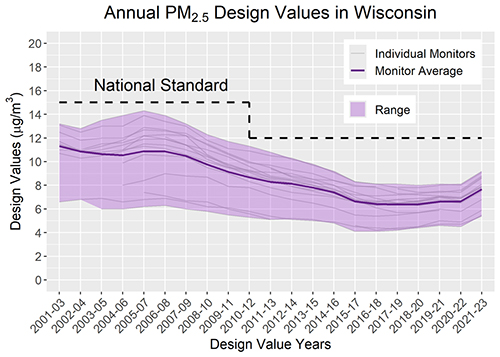Air quality at glance is available for perusing


This year’s annual air quality report covers 20 years, of state air monitoring data for air pollutants in Wisconsin, regulated under the Clean Air Act, including ground-level ozone, sulfur dioxide, nitrogen dioxide, carbon monoxide, particle pollution and lead. The report presents data from the 2023 calendar year, including the historic 2023 Canadian wildfire smoke events.
According to the Canadian Interagency Forest Fire Center, 15 million hectares (about two million acres larger than Wisconsin) burned in 2023 – more than six times the annual average in Canada.
“During the multi-day air quality advisory in late June, of last year, the air monitoring network measured some of the highest PM2.5 concentrations ever recorded in the state,” said Gail Good, DNR Air Management program director.
Wildfire smoke events in 2023, resulted in the DNR issuing 15 PM2.5 air quality advisories – almost five times higher than the average over the previous 12 years. PM2.5 advisories are issued when air quality has reached, or is expected to reach, the orange “unhealthy for sensitive groups” level on the Air Quality Index (AQI).
The design values used to assess PM2.5 concentrations are calculated over a three-year period. Despite the jump caused by 2023’s wildfire smoke, overall, PM2.5 concentrations have decreased 25 percent in the last 20 years, and all monitors measured concentrations below the 2012 federal air quality standards.
The report shows that over the last 20 years, statewide ozone concentrations have decreased by 15 percent. For decades, ozone concentrations have dropped across the state. However, that trend has slowed.
Last year’s wildfire smoke contained ozone-forming pollutants, which, combined with recent warmer-than-usual summers, contributed to increased ozone concentrations.
Wisconsin has implemented many programs that have reduced emissions of ozone-causing pollutants from power plants, industry and transportation in the state. However, these emission reductions have not resulted in the attainment of the 2015 ozone standard, because most ozonecausing emissions are transported across state boundaries and are outside Wisconsin’s control.
To better illustrate the latest trends, the DNR updated its Air Quality Trends Report Interactive StoryMap, which shows Wisconsin’s air quality trends for each pollutant, over the last 20 years. This tool provides an interactive visual to help convey the complex air quality data.
That is available at dnr.wisconsin.gov.

